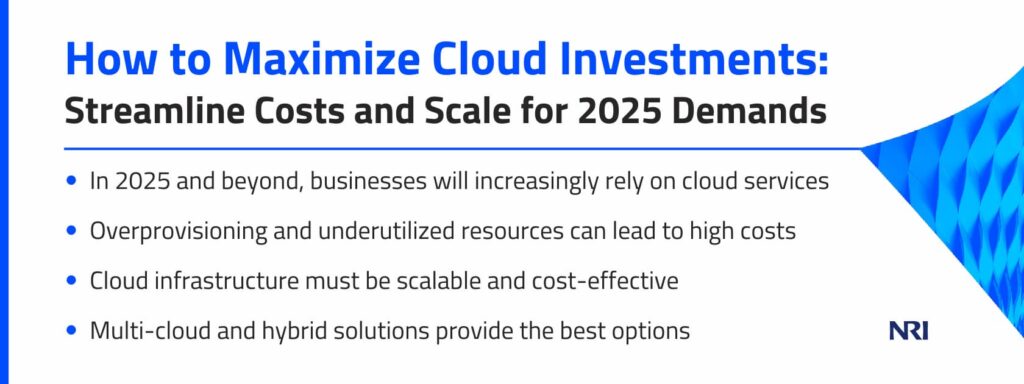While moving to the cloud is an inevitability for most businesses, high costs and rigid growth structures don’t need to be

The vast majority of businesses and organizations realize the necessity of leveraging cloud resources to maintain a competitive edge and to be able to scale as conditions change and opportunities arise.
The main challenge facing companies is managing their spending to maximize cloud investments and streamline cloud costs. They want to ensure that the solution they put into place is powerful enough to handle their needs now and as they may change.
To learn more about building a scalable cloud foundation, check out the webinar by Jessed Duggan, NRI Director of Innovation, and Mike Daughterty, Solution Architect.
The Challenges of Cloud Adoption
Your business is likely investing a lot in a cloud solution or will soon do so, so it is a necessity to understand the actual cost of poor cloud management. For example, IT sprawl caused by a lack of visibility into cloud footprint and usage could cause costs to grow uncontrollably and put you at risk of governance penalties and fines amounting to tens of millions of dollars.
Inefficient processes and workflows can cause productivity problems and even costly downtimes. Without proper management of cloud resources, it is impossible to ensure reliable performance across diverse workloads.
A strong cloud solution must optimize resource allocation, ensure system security, and implement strong governance frameworks to stay compliant with relevant regulations.
As an IT director, vice president, or senior executive, you need clear visibility into cloud usage and spending patterns to balance performance, scalability, and ROI.
Strategies for Streamlining Cloud Costs and Scaling Operations
Some of the key principles of cloud cost optimization and scaling include:
Right-Sizing Resources
Right-sizing involves optimizing workloads to match cloud capacity. This avoids over-provisioning resources, which can lead to waste and higher costs, or under-provisioning, which can cause performance to suffer. With right-sizing, you don’t overspend on unneeded capacity or create bottlenecks with inadequate resources.
Implementing Automation
An automated cloud platform system adjusts resources based on demand, using tools to monitor and auto-scale resources efficiently. Auto-scaling ensures that resources are added or removed based on traffic or server load. This capability helps save your company from overpaying during low-demand periods or avoid experiencing performance issues during high-demand work periods.
Leveraging Multi-Cloud and Hybrid Solutions
With a multi-cloud solution, you can balance performance and costs across cloud providers, both public and private. You can achieve peak performance and cost-efficiency while reducing data loss and downtime risks. A hybrid IT approach involves combining some in-house technology resources with cloud-based services that fill in performance gaps and extend your capabilities. This approach helps businesses to:
- Regulate their data
- Optimize costs
- Improve data security
- Achieve greater flexibility
- Meet compliance regulations
Utilizing Cloud Cost Management Tools
Cloud cost management tools can help businesses gain visibility into cloud cost issues to reduce unnecessary spending. The tools can gain insights into usage, highlight cost inefficiencies, and improve cloud spending by analyzing how you employ resources, set budgets, and automate actions across the entire cloud infrastructure. The best cloud cost management tools are easy to use, have a full set of features, and provide complete reporting.
How Cloud Scalability Supports Business Demands for 2025
Cloud scalability refers to a business’s cloud environment’s capacity to respond to changing workloads over time so there is no significant variation in performance or reliability. This sound structure also allows IT executives to predict costs for effective business planning.
Workloads in any organization are rarely consistent. Cloud-based processing requirements can ebb and flow with changes in projects and product offerings. So, scalability is essential.
Types of scaling can include:
- Vertical scaling—adding more physical hardware resources to existing ones, including central processing units (CPUs) and storage.
- Horizontal scaling—also known as “scaling out,” involves distributing workloads across further resources, such as adding more instances of a resource, such as servers, to the cloud setup.
- Diagonal scaling—the so-called “hybrid scaling” uses both vertical and horizontal scaling methods, taking advantage of the strengths of each to provide greater flexibility.
A scalable cloud architecture can help you to improve your business agility and your speed to market. It can also help you to:
- Control costs
- Improve security
- Boost performance
- Achieve reliability
- Expand geographic footprint
NRI’s Cloud Optimization Solutions
A lot is at stake in implementing and using the correct cloud solution for your business and its long-term success. Lost time and money can result from a poor or thoughtless choice. NRI remains committed to optimizing your cloud investment through our proven consulting services and tailored solutions.
We can help you with a modular hybrid solution that empowers you to leverage technology today and tomorrow. Contact us to start rethinking how you actually get business done and then find better ways to do it.
We also have a lot of resources available to help clients in their cloud journey. For example, you can download our eBook, “A Cloud Cost Optimization Checklist,” to assist with cloud optimization decisions, including meeting with stakeholders, setting expectations, discussing governance, creating a dashboard analyzing monthly spending, and much more.
Long-term success in 2025 relies on finding the best ways to achieve cloud cost optimization and scalability. You can begin that rewarding process now.



